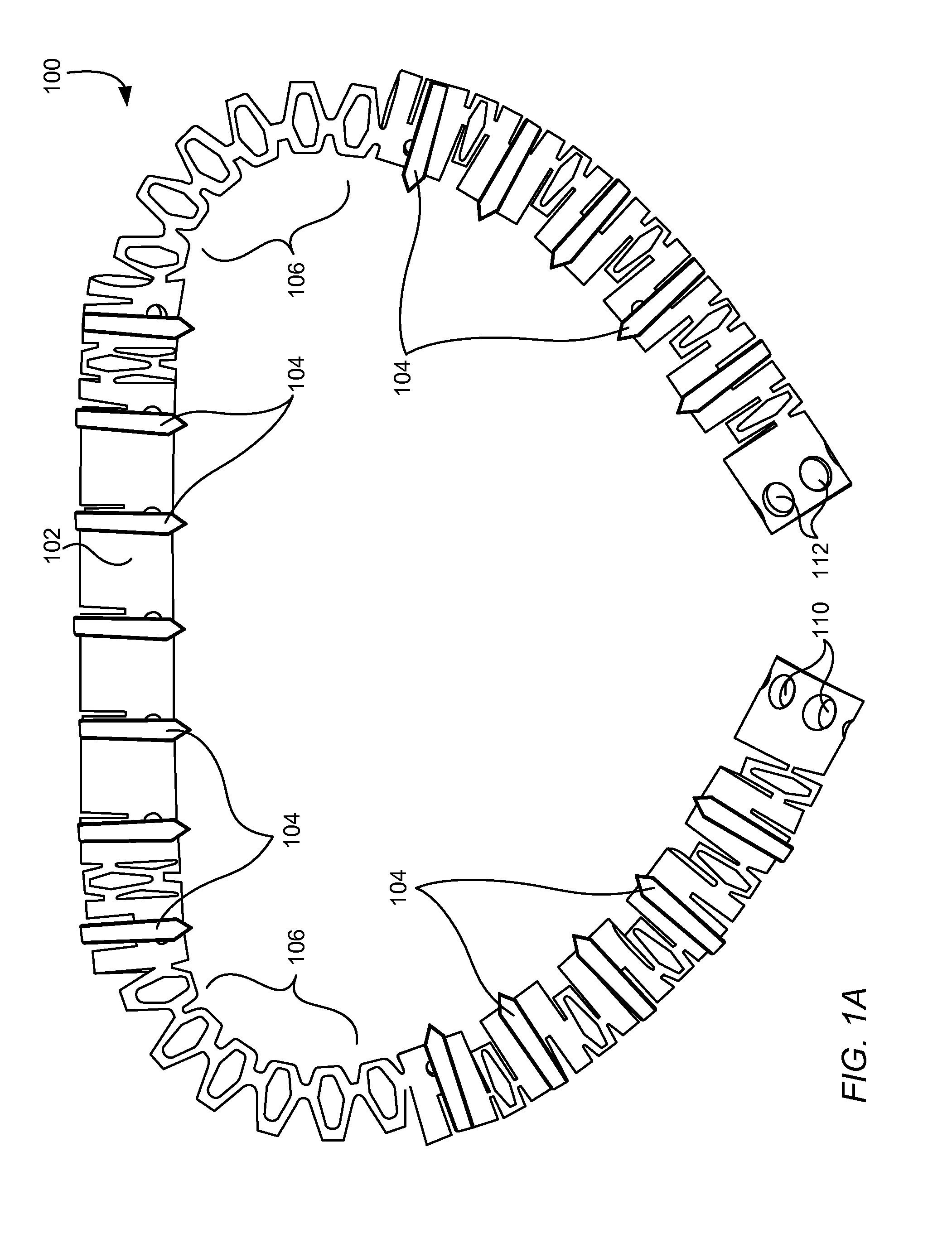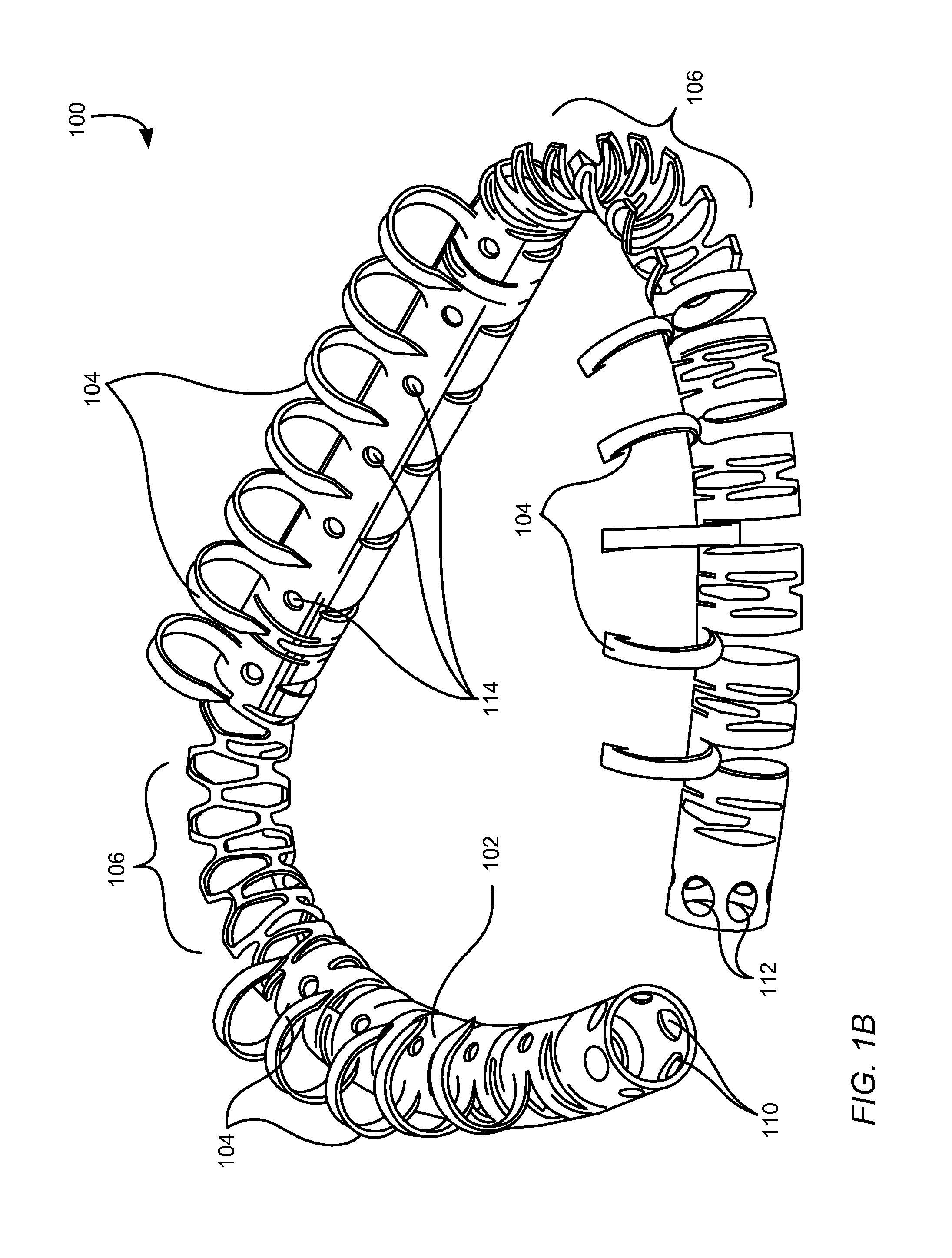Methods, devices, and systems for percutaneously anchoring annuloplasty rings
a technology of annuloplasty and percutaneous anchoring, which is applied in the field of percutaneous transcatheter repair of heart valves, can solve the problems of patient to a high risk of infection, prevent the valve from sealing properly, and long recovery tim
- Summary
- Abstract
- Description
- Claims
- Application Information
AI Technical Summary
Benefits of technology
Problems solved by technology
Method used
Image
Examples
example ring embodiments
with Separately Deployed Anchors
[0101]FIG. 8A is top view of an annuloplasty ring 800 in an operative geometry according to certain embodiments. The annuloplasty ring 800 illustrated in FIG. 8A is in an annular (D-shaped) operable geometry in a contracted state. The annuloplasty ring 800 is configured to enable percutaneous, transcatheter annuloplasty repair of a heart valve. The annuloplasty ring 800 may be fastened, percutaneously, to the annulus of the heart valve while in the expanded state and then reduced to the contracted state to decrease an A-P distance of the target valve and thereby improve leaflet coaptation of the target valve and reduce regurgitation through the target valve.
[0102]The annuloplasty ring 800 includes a body member 802 having a plurality of anchors 804, a plurality of anchor regions 806a, 806b, 806c (collectively 806), a plurality of expansion regions 808a, 808b (collectively 808), a plurality of anchor windows 810, a ring closure lock 812, and a pivot 81...
example anchor
Shapes and Designs
[0136]FIG. 13 is a view of various anchor shapes that may be used with the disclosed trans-catheter annuloplasty rings. Anchor shapes 1300, 1320, and 1330 have curved geometries and may be formed from superelastic material, such as Nitinol, so that they self-propel into annulus tissue. The variations in curvature and shape allow for the anchors to deploy into the annular tissue at differing depths. Anchor shape 1310 has a “wavy” geometry. The wave shape gives better grip into the tissue in certain environments. Anchor shape 1340 has a straight geometry and may be propelled into annular tissue through application of mechanical force (e.g., by inflating a balloon behind anchor 1340 or in the center of the annuloplasty ring). Artisans will recognize from the disclosure herein that combinations of barb designs and / or deployed configurations may also be used. In some embodiments, all of the anchors of an annuloplasty rings are of the same shape. In other embodiments, an...
example deployment embodiments
[0138]As discussed above, the annuloplasty ring embodiments disclosed herein are configured for percutaneous transcatheter delivery and fixation to heart valves. The annuloplasty rings may be delivered through a catheter to the mitral valve, for example, using a trans-septal approach, a retrograde approach, or a trans-apical approach. For example, FIG. 15A is a schematic diagram illustrating a trans-septal approach for endovascular delivery of an annuloplasty ring (not shown) to the mitral valve 1510 of a heart 1500 according to one embodiment. For illustrative purposes, a partial cross-section of the heart 1500 is illustrated to show the right atrium RA, right ventricle RV, left atrium LA, and left ventricle LV. For clarity, certain features (e.g., papillary muscles and chordae tendineae) are not shown. In the trans-septal approach shown in FIG. 15A, the left atrium LA is approached by advancement of a catheter 1512 through the inferior vena cava 1514, into the right atrium RA, acr...
PUM
 Login to View More
Login to View More Abstract
Description
Claims
Application Information
 Login to View More
Login to View More - R&D
- Intellectual Property
- Life Sciences
- Materials
- Tech Scout
- Unparalleled Data Quality
- Higher Quality Content
- 60% Fewer Hallucinations
Browse by: Latest US Patents, China's latest patents, Technical Efficacy Thesaurus, Application Domain, Technology Topic, Popular Technical Reports.
© 2025 PatSnap. All rights reserved.Legal|Privacy policy|Modern Slavery Act Transparency Statement|Sitemap|About US| Contact US: help@patsnap.com



